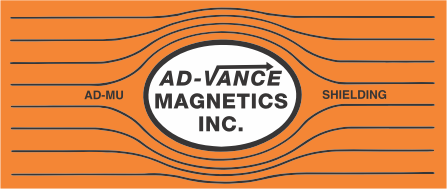FAQs &
Glosssary of Terms
Frequently Asked Questions:
Ad-Mu-80 is a soft magnetic high permeability shielding material that meets ASTM A 753-08 Alloy Type 4 and is equivalent to MIL-N-14411C Comp 1.
Ad-Mu-48 is a soft magnetic medium permeability shielding material that meets ASTM A 753-08 Alloy Type 2 and is equivalent to MIL-N-14411C Comp 3.
Also referred to as “Magnetic Permeability”. These terms refer to the magnitude of magnetization that the material acquires in reaction to a magnetic field. The higher the Permeability value is the better performance it will have in magnetic shielding applications.
A magnetic field is found in a region around around a magnet or electric current. Magnetic fields are typically seen by magnetic flux lines. The direction of these magnetic flux lines will show the direction of the magnetic field. The closer the flux lines are to each other the stronger the field is and vice versa if the flux lines are farther apart.
Magnetic shielding material and magnetic shields will re-direct the magnetic field so that it will no longer effect the application that is being shielded. Picture this similar to how a rock diverts water around itself in a river stream.
Since magnetic shielding alloys are sensitive to mechanical shock, such as stamping, bending, rolling, and other forming/fabricating operations there is a chance you can experience noticeable degradation. Other fabrication operations such as laser cutting, EDM, shearing, water jet cutting, and chemical photo etching will have a localized effect, if any. Depending on the application and requirements, if the material is already fully annealed a re-annealing process may not be necessary, but is always recommended.
Performing a final heat treatment on magnetic shields will remove any impurities or stress (fabrication processes) the magnetic shields may contain. In some applications a final heat treatment may not be specified or required but Ad-Vance Magnetics recommends it.
Once the shielding material has been annealed for either sheet or foil thickness it is to be handled with care to ensure no additional stress or shock is caused to the material. Some fabrication process can be performed with little degradation risks to the permeability. See question 6 for more information.
DC fields are the results of the Earth’s magnetic field. DC fields have a constant orientation. AC fields are from man made electrical units such as computers, power lines, transformers etc.. AC fields will vary in direction and intensity.
Glossary of Terms:
A/C Field: A varying magnetic field. AC fields originate from man made electrical devices.
Annealing: A special heat treatment of a metallic alloy, that will reach a desired temperature range to be held at for a predetermined time and then will have a controlled cooling rate down to room temperature.
Attenuation: This is the opposite of amplification. In magnetic shielding it refers to the amount of reduction that is achieved.
Coercive Force: Also known as coercivity, this represents the magnetic intensity needed to demagnetize a material.
Curie Point: A temperature point that creates a change in the magnetic properties of a material. Such as a ferromagnetic material becoming paramagnetic.
D/C Field: A slowly changing or non varying magnetic field. DC fields are a result of the Earth’s Magnetic field.
Electromagnetic Field (EMF): Is a physical field produced by electrically charged objects and consists of both electric and magnetic components.
Electromagnetic Interference (EMI): Is an unwanted disturbance that degrades, interrupts or limits the performance of electronics or electrical equipment.
Gauss: A unit of magnetic flux density which is equal to one ten-thousandth of a Tesla. Commonly associated with practical magnets in consumer products.
Magnetic Flux: The measurement of magnetic field strength over an area.
Magnetic Field Strength: Is a measurement of the intensity of the magnetic field which is derived from the amount of magnetic flux in a unit area that is perpendicular to the direction of the magnetic flow.
Magnetic Shielding: The protection from interference from a magnetic field.
Permeability: Is the degree of magnetization that a material will obtain from an applied magnetic field.
Oersted: A magnetic intensity unit of measurement, which is equal to the magnetic intensity one centimeter from a unit magnetic pole.
Saturation: Is a condition after the strength of a magnetic field becomes so large that further increases to the strength of the magnetic field yields no additional magnetization in the material.
Tesla: A Unit of of magnetic flux density used primarily with industrial electromagnets There are ten thousand gauss in one Tesla.

